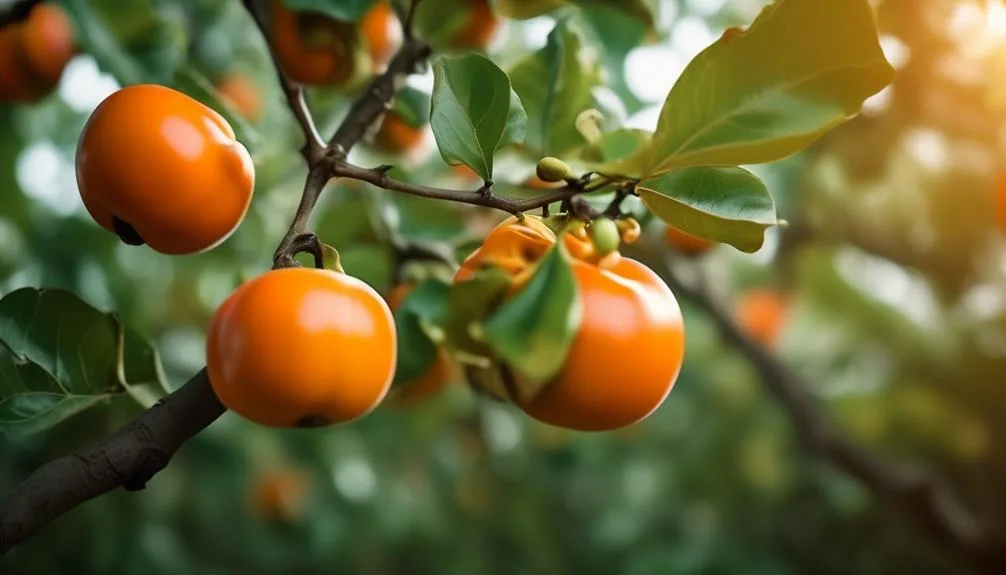Ever wondered why persimmons make your mouth feel dry and puckered?
The reason behind their astringent taste is quite complex, involving tannins, ripening process, cultivar variations, and environment.
Understanding these factors can shed light on the unique biology of persimmon trees and how we enjoy their fruits.
Key Takeaways
- Tannins are responsible for the astringency in persimmon fruit.
- The ripening process significantly reduces tannin levels and the puckering sensation.
- Different persimmon cultivars have unique characteristics that influence flavor, texture, and astringency.
- Environmental factors, such as climate and soil composition, play a crucial role in determining the astringency of persimmons.
Tannins and Astringency
Tannins are the compounds responsible for the astringency in persimmon fruit, giving them that characteristic dry, puckering sensation in your mouth when you bite into them.
During fruit development, tannin regulation plays a crucial role in determining the astringency level of the persimmon. Initially, the fruit contains high levels of tannins, which contribute to its astringent taste.
As the fruit matures, tannin regulation processes occur, leading to a decrease in tannin levels and a reduction in astringency. This regulation is essential for making the fruit palatable and enjoyable to eat.
Understanding the mechanisms behind tannin regulation during fruit development is vital for improving the overall quality of persimmons and ensuring a pleasant eating experience for consumers.
Role of Ripening Process
As the persimmon fruit ripens, a complex interplay of biochemical processes takes place, influencing its flavor, texture, and astringency.
The ripening process of persimmons involves enzymatic changes that significantly impact the fruit's characteristics. During ripening, the levels of tannins, responsible for the fruit's astringency, gradually decrease. This enzymatic breakdown of tannins reduces the puckering sensation associated with unripe persimmons, making the fruit more palatable.
Additionally, the ripening process transforms the texture of the fruit, turning it from firm and astringent to soft and sweet. The enzymatic changes also contribute to the development of the characteristic rich and sweet flavor of ripe persimmons.
Understanding the role of the ripening process sheds light on why persimmons transition from astringent and unappealing when unripe to lusciously sweet and enjoyable when fully ripe.
Impact of Cultivar Variations
The unique characteristics of different persimmon cultivars greatly influence the overall flavor, texture, and astringency of the fruit as it ripens. Cultivar selection plays a significant role in determining the fruit quality. Here are some popular persimmon cultivars and their key attributes:
| Cultivar | Flavor | Texture |
|---|---|---|
| Fuyu | Sweet and mild | Firm |
| Hachiya | Rich and tangy | Soft and pudding-like |
| Saijo | Honey-like | Smooth and custard-like |
Cultivar selection not only affects the taste and texture but also determines the astringency level of persimmons. Whether you prefer a crisp bite like the Fuyu or the luscious, jelly-like consistency of the Hachiya, understanding the impact of different cultivar variations is essential for enjoying the best persimmon fruit quality.
Environmental Factors and Astringency
Understanding how environmental factors influence astringency in persimmons can enhance your appreciation of the diverse flavors and textures offered by different cultivars.
The climate effects astringency by impacting the amount of tannins in the fruit, which is responsible for its characteristic puckering sensation.
Soil composition also plays a crucial role; persimmon trees grown in well-drained, slightly acidic soil tend to produce fruit with milder astringency, while those in clay or alkaline soils may yield more astringent fruit.
The interplay of these environmental elements creates a rich tapestry of flavors and textures, shaping the unique taste of each persimmon variety.
Embrace the complexity of environmental influences on astringency, and delve into the intricate balance of nature that gives persimmons their distinctive character.
Managing Astringency in Persimmons
To manage astringency in persimmons, consider employing various post-harvest techniques to reduce the level of tannins and enhance the fruit's palatability. Astringency removal techniques play a crucial role in improving fruit quality, aligning with consumer preferences, and meeting market demand. Below are some effective techniques for managing astringency in persimmons:
| Astringency Removal Techniques | Description |
|---|---|
| Controlled Atmosphere Storage | Storing persimmons in a controlled atmosphere environment with reduced oxygen levels can help soften the fruit and decrease astringency. |
| Ethanol Treatment | Immersing persimmons in ethanol solution can accelerate astringency removal, making the fruit ready for consumption sooner. |
| Carbon Dioxide Exposure | Exposing persimmons to controlled levels of carbon dioxide can promote astringency removal and improve overall fruit quality. |
Conclusion
In the end, the astringent taste of persimmons is a result of tannins. This taste can be influenced by ripening, cultivar variations, and environmental factors. By understanding these factors, one can appreciate and manage astringency. It allows individuals to savor the sweet, non-astringent varieties of this delightful fruit.

